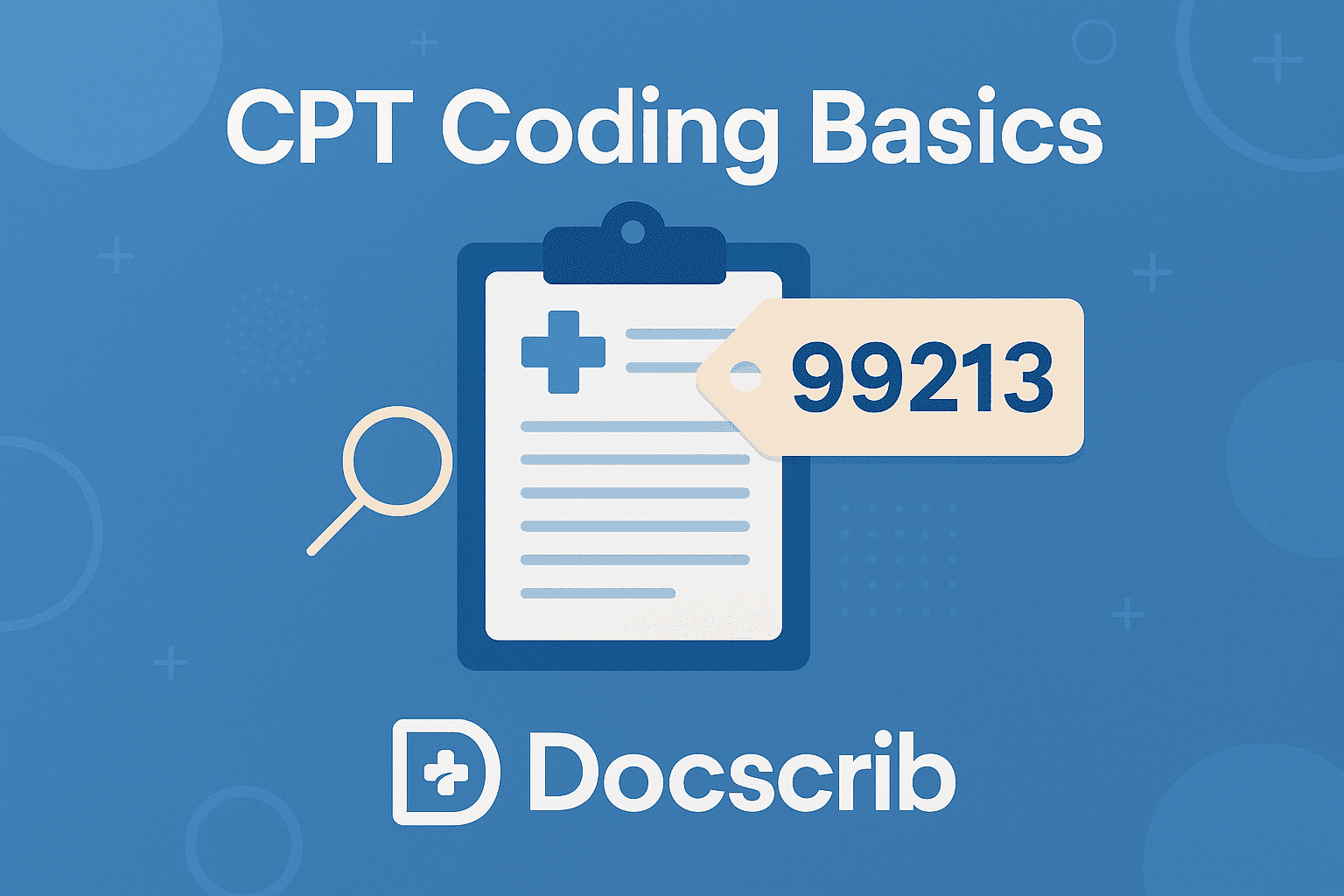Updated on: July 8, 2025
In the complex world of healthcare, accurate documentation and coding aren’t just administrative tasks—they’re essential for proper reimbursement, compliance, and patient care. One of the most critical components of this process is understanding CPT Coding Basics.
Whether you’re a seasoned provider, a new clinician, or a healthcare administrator, mastering the Current Procedural Terminology (CPT) codes is key to keeping your practice running smoothly. In this easy-to-follow guide, we’ll break down the fundamentals of CPT coding, and how modern tools like Virtual Medical Scribes from Docscrib can simplify the process for busy medical professionals.
What is CPT Coding?
CPT stands for Current Procedural Terminology—a standardized system maintained by the American Medical Association (AMA) to describe medical, surgical, and diagnostic procedures.
Every healthcare service provided to a patient, from a simple consultation to complex surgeries, is assigned a specific CPT code that:
-
Communicates the procedure to payers (like insurance companies)
-
Ensures accurate billing and reimbursement
-
Creates a standardized medical record
Why Should Clinicians Care About CPT Coding?
Incorrect CPT coding can lead to:
-
Claim denials or delays
-
Revenue loss
-
Compliance risks
-
Legal penalties
For clinicians, understanding CPT coding basics means fewer errors, faster payments, and better alignment between documentation and billing.
💡 Pro Tip: Using AI-powered tools like Docscrib’s Virtual Medical Scribes helps ensure your documentation matches the correct CPT code—without the extra workload.
The Three Main Types of CPT Codes
CPT codes are categorized into three main types:
1. Category I Codes
These are the most commonly used and cover:
-
Evaluation and Management (E/M) services
-
Surgical procedures
-
Radiology
-
Pathology and lab services
Example:
99213 — Office or other outpatient visit for an established patient, typically 15 minutes.
2. Category II Codes (Performance Measurement Codes)
-
Optional tracking codes
-
Used to measure quality of care and performance
Example:
G8427 — Documented that the patient was screened for tobacco use.
3. Category III Codes (Emerging Technology Codes)
-
Temporary codes for new and experimental procedures or technologies.
Example:
0563T — Transperineal percutaneous ablation of prostate tissue.
Key CPT Coding Basics Every Clinician Should Know
✅ Understand E/M Coding
Evaluation and Management codes (99XXX series) are among the most used in outpatient care. They’re based on:
-
History
-
Examination
-
Medical decision-making (MDM)
-
Time spent with the patient
👉 Tools like Docscrib help automate note-taking and time capture—two critical elements of accurate E/M coding.
✅ Link ICD-10 Codes with CPT Codes
-
ICD-10 codes describe the diagnosis.
-
CPT codes describe the service provided.
Both must align to justify medical necessity and ensure payment.
✅ Use Modifiers Correctly
Modifiers add specificity to a CPT code, indicating:
-
A procedure was altered in some way
-
Multiple procedures were performed
Example:
Modifier -25: Significant, separately identifiable E/M service on the same day as another procedure.
✅ Stay Updated
CPT codes are updated annually. Keeping up with changes is crucial to avoid denials or underpayment.
How Virtual Medical Scribes Can Simplify CPT Coding
Clinical documentation is the foundation of accurate CPT coding. But with increasing patient loads, providers often struggle to:
-
Complete notes in real time
-
Capture the necessary details for correct coding
-
Avoid after-hours charting (aka “pajama time”)
That’s where Virtual Medical Scribes like Docscrib come in:
-
AI-powered documentation that listens, transcribes, and summarizes encounters
-
Ensures the right level of detail for coding
-
Frees up providers to focus on patient care—not paperwork
👉 Want to see how Docscrib can help?
Book a Free Demo ➔
Common Mistakes in CPT Coding—and How to Avoid Them
| Mistake | Solution |
|---|---|
| Undercoding (Choosing a lower-level code) | Review documentation carefully; use AI scribes for completeness |
| Overcoding (Choosing a higher-level code) | Ensure the documentation supports the code level |
| Missing Modifiers | Use checklists or AI assistance |
| Incorrect Link to ICD-10 | Double-check diagnosis-service alignment |
CPT Coding Basics: Key Takeaways
| CPT Coding Tip | Why It Matters |
|---|---|
| Use the correct E/M level | Prevents claim denials |
| Ensure ICD-10 and CPT alignment | Validates medical necessity |
| Apply Modifiers when necessary | Avoids reimbursement errors |
| Leverage AI-powered documentation | Saves time and boosts accuracy |
Final Thoughts: Simplifying CPT Coding with Docscrib
Mastering CPT Coding Basics doesn’t have to be overwhelming. With the right knowledge—and the right tools—you can:
✅ Improve documentation accuracy
✅ Reduce billing errors
✅ Save time and prevent burnout
By integrating Docscrib’s Virtual Medical Scribes into your workflow, you can ensure that every patient encounter is properly documented, coded, and billed—without the stress.
👉 Get started today with a free demo:
Schedule Your Demo Here ➔
